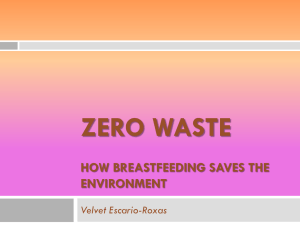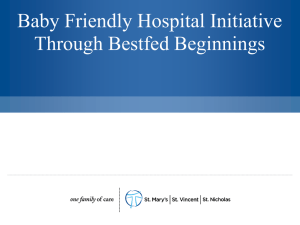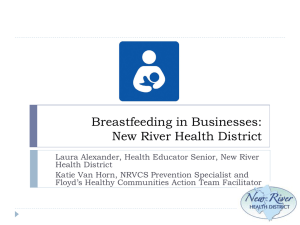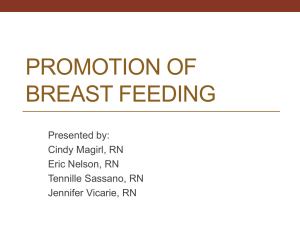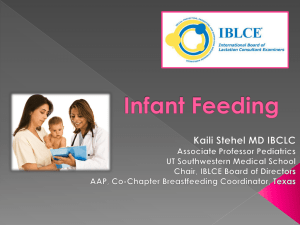Texas Ten Step Program
advertisement
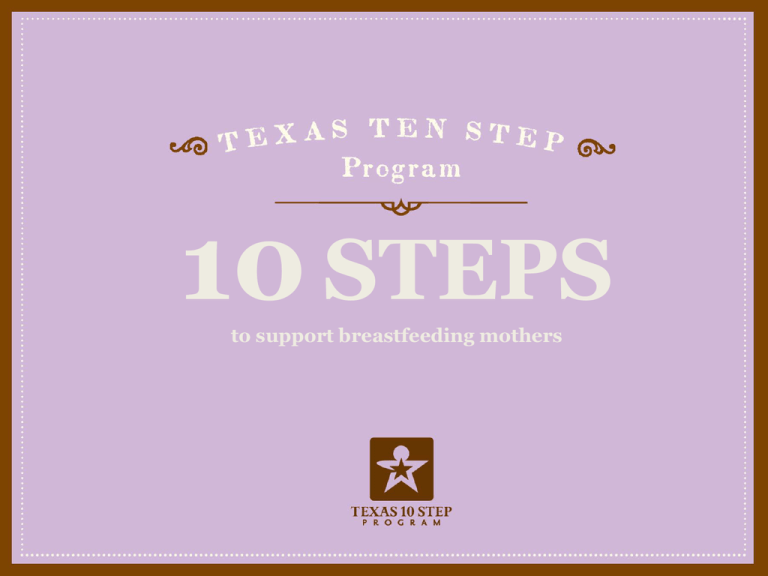
10 STEPS to support breastfeeding mothers QUOTES FROM PROFESSIONALS “As a neonatologist I have always strongly encouraged the mothers of all of my patients to provide their breastmilk for their babies. A mother’s own milk is always the best feeding option.” Susan Sward-Comunelli, MD Founder of the Mothers’ Milk Bank of North Texas THE TEXAS TEN STEP PROGRAM Recognizes hospitals and birth centers that provide optimal breastfeeding support to new mothers Offers trainings and updates Supports facilities in reaching the Healthy People 2020 goals. THE HEALTHY PEOPLE 2020 GOALS Increase Texas breastfeeding initiation rates to 82% Increase the percent of Texas infants breastfeeding at 6 months to 61% Increase the percent of Texas infants breastfeeding at 12 months to 34% Increase the percent of Texas infants exclusively breastfeeding at 3 months to 44% Increase the percent of Texas infants exclusively breastfeeding at 6 months to 24% THE HEALTHY PEOPLE 2020 GOALS • Reduce the proportion of breastfed newborns who receive formula supplementation within the first 2 days of life to 16% • Increase the proportion of live births that occur in facilities that provide recommended care for lactating mothers and their babies to 8% • Increase the proportion of employers that have worksite lactation support programs to 38% WHY SHOULD WE BECOME A TEXAS TEN STEP FACILITY? Over 75% of women in the state of Texas are choosing to breastfeed their infants These women are seeking medical care that will support them in this decision The Texas Ten Step designation will help you advertise as a breastfeeding friendly facility QUOTES FROM PROFESSIONALS Enthusiastic support and involvement of pediatricians in the promotion and practice of breastfeeding is essential to the achievement of optimal infant and child health, growth, and development. – AAP The American College of Obstetricians and Gynecologists strongly supports breastfeeding and calls upon its Fellows, other health professionals caring for women and their infants, hospitals and employers to support women in choosing to breastfeed their infants. All should work to facilitate the continuation of breastfeeding in the work place and public facilities. Breastfeeding is the preferred method of feeding for newborns and infants. Health professionals have a wide range of opportunities to serve as a primary resource to the public and their patients regarding the benefits of breastfeeding and the knowledge, skills and support needed for successful breastfeeding. – ACOG HOW WILL MY FACILITY BENEFIT FROM RECEIVING THE DESIGNATION? The TTS designation can be used to advertise the expert care your facility provides to breastfeeding women Your facility will be provided with a variety of items to advertise your commitment to offering infants the very best care. The Texas Department of State Health Services will provide you a unique log-in that will allow you to order breastfeeding materials for your patients free of charge. HOW DO I APPLY? Create policies that protect and promote breastfeeding Applications are located at: www.texastenstep.org/apply DSHS WILL SUPPORT EFFORTS TO MEET THE TTS CRITERIA BY PROVIDING: Free on-site breastfeeding trainings Free breastfeeding materials for patient education Additional training for staff off-site STEP 1 Make breastfeeding the preferred method of infant feeding. DEVELOP POLICIES THAT PROMOTE BREASTFEEDING AS THE PREFERRED METHOD OF INFANT NUTRITION All interventions and care plans should protect this valuable resource Decisions to interrupt breastfeeding or withhold human milk should be evidence based Policies should be communicated to staff upon employment and updated on a regular basis Sample Policies can be found at http://bfmed.org/ace-files/protocol/mhpolicy_ABM.pdf. STEP 2 Employees who care for mothers and infants should receive breastfeeding training within six months of employment, with updates provided on a regular basis. Training can be offered in house by the Department of State Health Services at no charge. CE’s are available for: -Breastfeeding Management -Breastfeeding the Compromised Infant -Managing Breastfeeding Complications To schedule a training through DSHS please contact: Hellen Sullivan Hellen.Sullivan@dshs.state.tx.us (512) 341-4591 STEP 3 Breastfeeding is presented as the feeding choice for all mothers, including those that must be separated from their infant. PRENATAL CLASSES AND HOSPITAL TEACHINGS SHOULD INCLUDE: The health risks associated with not breastfeeding Principles of milk establishment and supply Importance of skin-to skin contact Maintaining lactation if mother and infant are separated STEP 4 Mothers are encouraged to breastfeed their newborn within one hour of birth, within 30 minutes is ideal. SKIN-TO-SKIN CONTACT Mothers with c-sections or complications should be assisted to breastfeed as soon as possible Mothers should have the opportunity for early skin-to-skin contact regardless of type of delivery *Protocols for skin-to-skin after birth and research supporting this contact can be found at: http://bfmed.org/ace-files/protocol/peripartum.pdf STEP 5 Breastfeeding should be assessed within six hours after birth and at least once per shift. There should be staff with training beyond the basics of breastfeeding to assist with unusual management concerns (IBCLC, nurses or physicians with additional training). Additional training could include staff that have attended Principles of Lactation Management and Lactation Counseling and Problem Solving (Trained Breastfeeding Educators) or staff that have clinical breastfeeding training. Staff can register for these trainings at: http://www.dshs.state.tx.us/wichd/lactate/courses.shtm. STEP 6 Newborns should be given artificial human milk only if it is medically indicated and ordered by the physician or requested by the parent. Policy should state that the parents are advised on the impact of introducing formula prior to establishing breastfeeding If infant needs supplementation staff should protect breastfeeding while offering the supplement Protocols on supplementation and methods of supplementation can be found at: http://bfmed.org/ace-files/protocol/supplementation.pdf STEP 7 Mothers and newborns should be encouraged to room-in unless separation is medically indicated. Limit time away from mother for medical procedures Nurses should help families plan for periods of rest during their hospital stay. If the mother requests newborn be brought to the nursery, the infant should be brought to the mother when hunger cues are evident. Additional information on peripartum breastfeeding management can be found at: http://bfmed.org/ace-files/protocol/peripartum.pdf STEP 8 Mothers should be encouraged to breastfeed their newborns without restriction and breastfeeding should take priority over non-emergent events. Mothers should be instructed to: • • • • • Recognize early hunger cues Assess latch and adequate feed Monitor wet and soiled diapers Recognize normal feeding patterns of a newborn Recognize changes in the infants feeding patterns as the infant goes through growth spurts and starts solids STEP 9 Artificial Nipples should be discouraged for the healthy newborn. Alternate feeding methods should be used if supplementation is necessary. Expressed breastmilk should be the first choice if supplementation is necessary. Mothers should not be given discharge packs that include formula or formula advertisements. Protocols for supplementing a breastfeeding infant can be found at the Academy of Breastfeeding Medicine’s website: http://bfmed.org/ace-files/protocol/supplementation.pdf STEP 10 Breastfeeding mothers should receive support following discharge. Follow up should include a list of resources including: - Online resources such as www.breastmilkcounts.com Telephone hotlines Area Mother-to-Mother support meetings IBCLCs’ in the area Hospitals can provide a lactation clinic, in-home visitation or follow-up phone calls to support breastfeeding moms. WIC Peer Counselors can be a great resource for breastfeeding families and hospital staff. For information on this program please contact: Jewell Stremler Jewell.Stremler@dshs.state.tx.us (512) 341-4593 MOTHER FRIENDLY WORKSITE Texas Ten Step facilities must be designated as a MotherFriendly Worksite. This designation shows that you support your staff in giving their infants the very best. Information on applying to become a Mother Friendly Worksite can be found at: http://www.dshs.state.tx.us/wichd/lactate/mother.shtm


